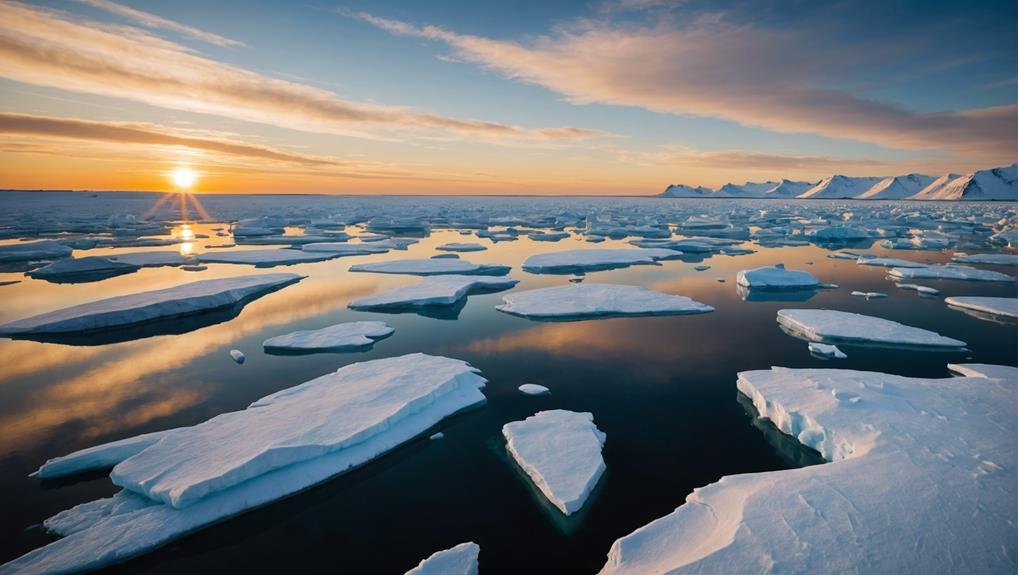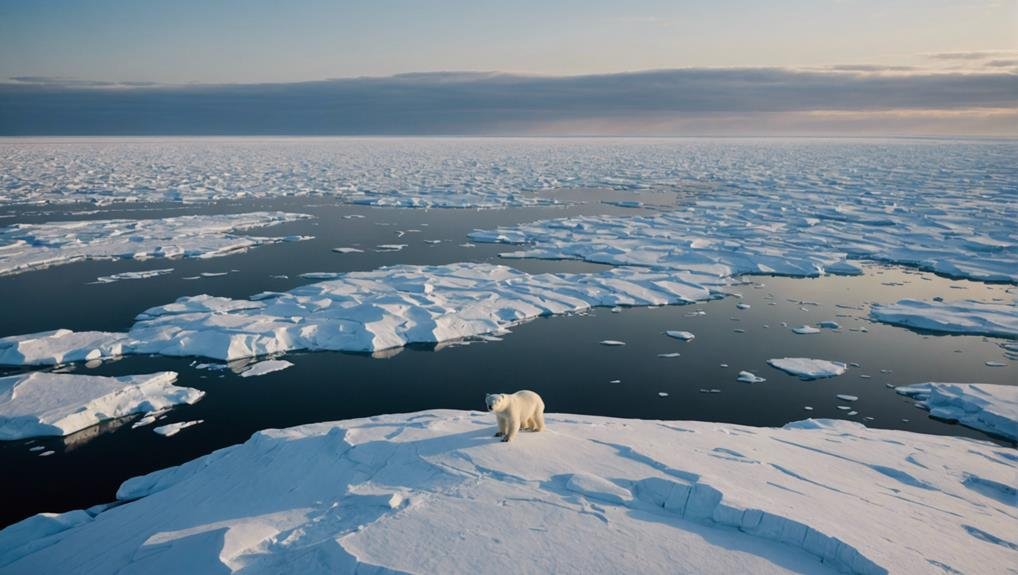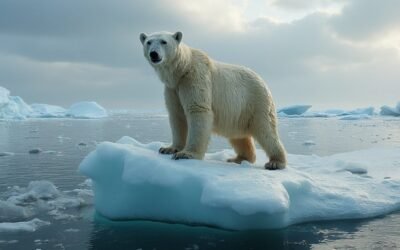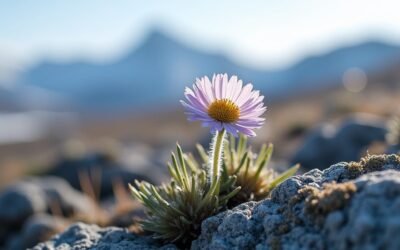To boost polar bear survival in the warming Arctic, you can take several impactful steps. In the first place, reduce your carbon footprint by adopting renewable energy sources and supporting clean energy policies. Next, halt Arctic oil drilling to prevent habitat disruption and pollution. Engage in public education about the impact of climate change on polar bears and advocate for wildlife conservation policies that protect their habitat. Monitor polar bear habitats using advanced technology to aid in conservation efforts. Lastly, engage with your community in sustainable practices and support research funding for innovative conservation strategies. These actions can make a significant difference in preserving polar bear populations, revealing even more approaches as you explore further.
Main Points
- Support policies that restrict Arctic oil drilling to protect polar bear habitats.
- Increase public awareness and education on the impacts of climate change on polar bears.
- Fund research focused on polar bear conservation and their changing habitats.
- Advocate for and adopt renewable energy sources to reduce greenhouse gas emissions.
- Participate in community actions like local clean-ups to minimize environmental pollution.
Reduce Greenhouse Emissions
To boost polar bear survival, we must reduce greenhouse gas emissions that contribute to the melting of their Arctic habitat. You have an important role in this effort, as the choices you make every day can have a significant impact on the environment. Shifting to renewable energy sources is one of the most effective ways you can help. Instead of depending on fossil fuels, which release large amounts of carbon dioxide, opting for renewable energy such as solar, wind, or hydroelectric power can greatly reduce greenhouse emissions.
Investing in clean energy not only benefits polar bears but also improves overall air quality and reduces global reliance on oil and coal. By supporting policies that promote renewable energy, you're advocating for a sustainable future and helping guarantee that polar bears continue to thrive in their natural habitat.
Moreover, reducing your carbon footprint is another important step. Simple actions like reducing energy consumption, choosing energy-efficient appliances, and minimizing car travel can make a big difference. Every bit of energy you save contributes to fewer emissions entering the atmosphere.
Educating others about the importance of reducing greenhouse gas emissions is also essential. The more people understand the connection between their actions and the survival of polar bears, the more likely they're to change their habits.
Halt Arctic Oil Drilling
While reducing greenhouse emissions is vital, it's equally important to halt Arctic oil drilling to protect polar bear habitats from further harm. The continuous push for oil extraction not only risks catastrophic oil spills but also increases everyday pollution, severely disrupting the fragile ecosystem that polar bears rely on for survival.
You mightn't realize the extent to which Arctic oil drilling interferes with polar bear life. The noise and human activity associated with drilling operations disturb the natural behavior of these majestic creatures, affecting their hunting patterns and access to food. This is particularly damaging during critical times such as breeding and denning seasons, where any disturbance can have long-lasting effects on their population stability.
Halting oil drilling in the Arctic isn't just about preventing potential disasters; it's about actively choosing to reduce stress on polar bear populations that are already under severe pressure from climate change. By advocating for policies that restrict or altogether cease oil drilling in these regions, you contribute significantly to polar bear conservation efforts.
Protecting polar bear habitats from the threats of Arctic oil drilling is a direct action that supports the overall health of the Arctic environment. As oil drilling diminishes, the risk of oil spills, which can devastate marine and terrestrial ecosystems for decades, also decreases. This proactive approach is essential not only for the survival of polar bears but also for maintaining the ecological balance of the Arctic region.
Promote Renewable Energy

Shifting to renewable energy sources like solar and wind greatly decreases greenhouse gas emissions, directly benefiting polar bear habitats in the warming Arctic. By embracing these cleaner energy options, you're not only contributing to the reduction of global warming but also playing an essential role in preserving the delicate ecosystem that polar bears rely on.
Investing in renewable energy technologies is pivotal. It lessens our dependence on fossil fuels, which are major contributors to greenhouse gas emissions and the subsequent Arctic warming. When you support policies that facilitate the development of renewable energy, you're helping to mitigate climate change's impact on polar bear populations. This shift not only protects these majestic creatures but also fosters a sustainable environment for future generations.
Moreover, renewable energy projects aren't just about environmental benefits; they also offer economic advantages. These initiatives create job opportunities and stimulate economic growth, which can be particularly beneficial in regions affected by the shift away from fossil fuel industries. By advocating for and investing in renewable energy, you're contributing to a robust economy that supports both human and wildlife communities.
Implementing renewable energy solutions is a proactive step towards combating global warming. It's a sustainable strategy that enhances the survival prospects of polar bears in the Arctic. Your involvement and advocacy can drive change, encouraging more extensive adoption of renewable energy across the globe. By doing so, you're ensuring a healthier planet where polar bears and other wildlife can thrive despite the challenges posed by a changing climate.
Enhance Energy Efficiency
Improving energy efficiency in your home and workplace can greatly reduce carbon emissions that warm the Arctic, threatening polar bear habitats. By taking simple steps to increase energy efficiency, you're directly impacting the fight against climate change and the alarming sea ice loss that endangers these majestic creatures.
Switching to energy-efficient appliances and LED lighting in your home is a practical move with substantial impacts. These products use less electricity, which means lower carbon emissions. This reduction is essential as it helps to slow down the warming of the Arctic, an important factor in preserving polar bear environments.
But it's not just about what's in your home. Consider your daily commute; opting for public transportation, biking, or carpooling instead of driving alone can significantly reduce your personal carbon footprint. Each car off the road means less fuel burned, fewer emissions, and a smaller contribution to global warming.
Don't overlook the importance of insulating your living and working spaces either. Proper insulation means less energy is needed for heating and cooling, which reduces energy consumption and greenhouse gas emissions. This step not only helps mitigate the impact on the Arctic but also cuts your energy bills.
Lastly, support the growth of renewable energy projects like solar and wind. These technologies are essential for moving away from fossil fuels, which are major drivers of climate change and sea ice loss.
Educate the Public

Educating the public about the threats global warming poses to polar bears is crucial for spurring collective action. You can play a pivotal role in this by understanding and sharing how climate change affects these majestic creatures. Polar bears rely heavily on sea ice for hunting seals, their primary food source. As the planet warms, this ice melts earlier each season, drastically reducing their habitat and the time they've to build fat reserves essential for their survival.
When you learn about the direct link between climate change and the diminishing sea ice, you're better equipped to communicate the urgency of the situation. Knowing that the survival of polar bears is at stake helps you grasp the broader impact of global warming. It's not just about warmer winters or melting glaciers; it's about the very existence of species that define the Arctic ecosystem.
Furthermore, understanding that reducing greenhouse gas emissions can slow down sea ice loss empowers you to advocate for and adopt practices that lessen your carbon footprint. By choosing sustainable transportation, supporting renewable energy solutions, and being mindful of energy consumption, you're contributing to a global effort to mitigate the effects of climate change.
Educating yourself and others creates a ripple effect. As more people become aware of how their actions impact polar bears, collective pressure mounts on industries and governments to adopt more sustainable policies. Remember, every small action adds up, and your informed choices can help make sure that polar bears continue to roam the Arctic for generations to come.
Support Wildlife Policies
While you learn and share information about climate change's impact on polar bears, it's equally important to support wildlife policies that protect their dwindling habitats. Advocating for these measures can make a significant difference in the survival of polar bears in the Arctic. By backing wildlife policies, you're contributing to the creation of a safer environment for these majestic creatures, ensuring they continue to roam their icy homes for generations to come.
Effective wildlife policies can regulate human activities in polar bear territories, which reduces potential conflicts and threats to the species. It's essential to understand that each time a policy is put in place that limits disturbances in these areas, it directly benefits the polar bears' chances of survival. By supporting policies that establish conservation areas and marine protected areas, you help safeguard critical habitats from the encroaching dangers posed by climate change and human interference.
Moreover, implementing wildlife policies promotes sustainable practices that are important for the health of the Arctic ecosystem. These policies ensure that the natural behaviors and breeding patterns of polar bears aren't disrupted by external pressures. Your support for strong wildlife policies not only helps in preserving the current polar bear populations but also assists in paving the way for future conservation efforts.
Monitor Polar Bear Habitats

Monitoring polar bear habitats is essential to understand how changing sea ice conditions impact their survival. As you're keenly aware, the Arctic environment is undergoing significant transformations due to climate change, affecting the very foundation of polar bear existence: the sea ice. By keeping an eye on these habitats, we can gauge the severity and immediacy of threats they face, thereby informing and directing conservation efforts more effectively.
Here are three critical reasons why monitoring is indispensable:
- Tracking Sea Ice Extent: Satellite technology offers real-time data, enabling us to observe fluctuations in sea ice cover. This is important as polar bears depend on sea ice for hunting seals, their primary food source.
- Understanding Habitat Shifts: Monitoring provides insights into how and where the habitat is changing. This knowledge is crucial for predicting polar bear movements and behavior, helping us anticipate areas they might migrate to as ice conditions evolve.
- Tailoring Conservation Efforts: By identifying the regions where polar bears are most at risk, conservation strategies can be specifically designed to target those areas, enhancing the effectiveness of protective measures.
Incorporating advanced monitoring technology, understanding the human impact, and reinforcing conservation efforts are all intertwined in the mission to safeguard these majestic creatures. While it's a complex challenge, your engagement and support in these efforts are what'll ultimately make a difference. Remember, every piece of data helps in building a clearer picture of what these bears need to thrive despite the challenges posed by a warming Arctic.
Fund Conservation Research
Building on our understanding of habitat changes, it's essential to invest in conservation research to develop strategies that effectively support polar bear survival. As the Arctic warms, the sea ice—polar bears' primary habitat—continues to diminish. This loss directly threatens their ability to hunt, mate, and ultimately survive. By funding research, you're helping scientists uncover how these changes in sea ice affect bear populations and what can be done to mitigate these impacts.
Research funded by organizations like the International Polar Bear Conservation Group provides critical insights into the behaviors and needs of polar bears in a changing climate. This knowledge is invaluable for crafting targeted conservation strategies. For instance, understanding the seasonal patterns of sea ice retreat can help predict polar bear movements, improving the management of their critical habitats.
Furthermore, conservation research can identify innovative solutions that may not be immediately obvious. These might include developing new technologies for monitoring bear populations or exploring sustainable human-bear coexistence strategies. Your investment in this research doesn't just support the bears; it contributes to the broader understanding of Arctic ecosystems and their responses to climate change.
Engage in Community Action

You can make a direct impact on polar bear conservation by engaging in community action initiatives. By participating locally, you're not just helping to save polar bears, but also setting a precedent for sustainable practices that can make a significant difference globally.
Here are some effective ways to engage:
- Participate in Local Clean-ups: Join local efforts to clean up natural habitats that directly or indirectly affect polar bear populations. Reducing pollution can lessen the broader environmental impact and contribute to healthier ecosystems.
- Support Sustainable Community Initiatives: Advocate for and support local measures that promote sustainable living. This reduces the overall carbon footprint, which is important for slowing down the Arctic ice melt that threatens polar bear habitats.
- Educate and Advocate: Learn about the challenges polar bears face and share this knowledge within your community. Push for policies and practices that prioritize renewable energy and other measures that reduce greenhouse gas emissions.
Adopt Climate-friendly Practices
Adopting climate-friendly practices can greatly reduce your carbon footprint, directly aiding in the preservation of polar bear habitats. As the Arctic warms, the loss of sea ice—a critical habitat for polar bears—accelerates, making it essential to take action to stabilize the global climate. By choosing renewable energy sources like solar or wind power, you're not only cutting down on emissions but also fostering a sustainable future that benefits both humans and wildlife.
Additionally, opting for energy-efficient appliances and lighting in your home can substantially lower greenhouse gas emissions. These technologies have become more accessible and cost-effective, allowing you to make environmentally sound choices without sacrificing convenience or functionality. By reducing your energy consumption, you're directly contributing to the decrease in demand for fossil fuels, which is crucial for slowing Arctic ice melt.
Supporting policies that promote sustainable practices and conservation efforts is another powerful way to impact the Arctic ecosystem positively. Engage with local and national initiatives that aim to protect the environment and advocate for the implementation of stringent environmental regulations. Educating others about the effects of climate change on the Arctic and its wildlife, particularly polar bears, raises awareness and encourages more people to adopt eco-friendly habits.
Lastly, advocating for responsible waste management and recycling can further reduce your environmental impact. Effective recycling helps minimize the waste that ends up in landfills, reducing greenhouse gas emissions and conserving natural resources—a small but meaningful step toward protecting the Arctic and its inhabitants.
Frequently Asked Questions
What Helps Polar Bears Survive in the Arctic?
To survive in the Arctic, you'd rely heavily on seal hunting strategies, adept ice floe navigation, and a thick fat layer for insulation and energy.
Analyzing denning behavior is also essential, as it affects reproductive success and cub survival.
These skills are indispensable for enduring the harsh conditions and scarce food availability due to the melting ice.
Understanding and enhancing these abilities are key to maintaining their presence in their rapidly changing habitat.
How Can We Help Polar Bears From Global Warming?
To help polar bears combat global warming, you can engage in activities that prevent ice melting, such as advocating for renewable energy sources.
Enhancing international cooperation and promoting climate change education are vital steps.
Additionally, adopting sustainable tourism practices can minimize environmental impacts in polar regions.
How Can a Polar Bear Survive in the Heat?
To survive the heat, you, as a polar bear, must adapt your behaviors. Seek out shade and rest during the hottest parts of the day to avoid overheating.
Immersing yourself in cold water can help regulate your body temperature effectively. Consider modifying your diet to require less hunting effort, which reduces exertion and heat production.
Adopting these cooling behaviors and making use of available water and shade are crucial for your survival in warmer conditions.
What Are Two Ways That Polar Bears Are Adapted to Survive in Cold Climates?
Polar bears are vitally equipped to thrive in frosty habitats.
First, their insulating fur and substantial fat reserves keep them toasty amid icy temperatures, allowing them to conserve energy efficiently.
Additionally, as strong swimmers with sharp claws, they can navigate and hunt in their chilling environment adeptly.
These adaptations are essential for enduring the harsh Arctic conditions and successfully locating their primary food source, seals.
Are the Climate Change Protection Tips for Polar Bears Effective in Boosting Their Survival in a Warming Arctic?
The warming Arctic has placed polar bears in a vulnerable position, but various climate change protection tips are being implemented to safeguard their future. Efforts to reduce greenhouse gas emissions, protect their habitat, and promote sustainable practices are steps aimed to protect polar bears from further decline amid rising temperatures.
Conclusion
In summary, you play a vital role in preserving polar bears by promoting policies that protect their precarious habitats. Prioritize reducing greenhouse emissions, halting harmful arctic drilling, and pushing for progress in renewable energy.
Each effort you make, from enhancing energy efficiency to educating others, contributes significantly to conservation. By adopting climate-friendly practices and engaging in community action, you can help guarantee these majestic creatures continue to thrive in their Arctic home.


